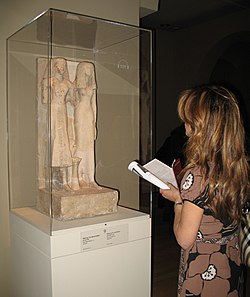Art definitions, artistic roles, and visual thinking/Basics
| Art Appreciation and Techniques (#ART100) | |
|---|---|
| Art definitions, artistic roles, and visual thinking | Overview | Introduction and definitions | Basics | Artistic roles | Artistic categories | Artistic styles | Perception and visual awareness | Summary |
Form, content, aesthetics, and perspective are some of the basic considerations that contribute to understanding and forming an opinion about a work of art.
Form and content
Two basic considerations we need to be acquainted with are form (the physical and visible characteristics inherent in works of art), and content (the meaning we derive from the work). These two terms help people to understand what art has to offer us. As we examine art from different times, styles, and cultures, the issues of form and content will apply to all of them. Formal distinctions include a work's size; medium (painting, drawing, sculpture, or other kind of work); and descriptions of compositional elements (lines, shapes, and colours) involved. Issues of content include any visual clues that provide an understanding of what the art tells us. Sometimes, an artwork's content is vague or hidden and needs more information than is present in the work itself. We'll explore form and content further in later sections.
Aesthetics
Aesthetics is the philosophical argument about the nature of beauty. It's an idea central to any exploration of art. Aesthetics deals with notions of taste, cultural conventions, and the judgments we make based on our perceptions.
As deep as visual art is embedded in the fabric of our lives, it still is a source of controversy and irony. It thrives on common experience yet contradicts ideas of ourselves. Art is part of the culture it's created in but can reflect many cultures at once. Art has become probably more complex than ever, and we need a way to access the visual information of our society, of past cultures, and cultures not known to us to have a way to understand what we are looking at.
Subjective and objective perspectives
So, the first level in approaching art is learning to look at it. In future discussions, you will spend more time in pure observation than you probably have done before. Generally, we tend to look at art in terms of "liking" it first, and "looking" at it later. From this perspective, the subjective (knowledge residing in the emotions and thoughts of the viewer) almost completely dominates our way of looking at art. In the arts, it is especially important to begin to develop an informed, or objective, opinion rather than just an instinctual reaction. An objective view is one that focuses on the object's physical characteristics as the main source of information. This does not mean that you will remove or invalidate your subjective feelings about a work. In fact, you will find that the more informed you become, the more artwork will affect you emotionally and intellectually. It does mean, however, that you will learn alternative ways to approach art, ways that allow you to find clues to meaning and to understand how art reflects and affects our lives.
It's complex, but the satisfaction of looking at art comes from exploring the work to find meaning, not shying away from it simply because we don't understand it. Finding a definition is important because of the role art plays in societies and cultures.
